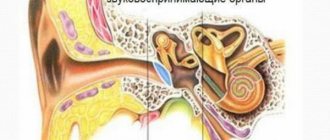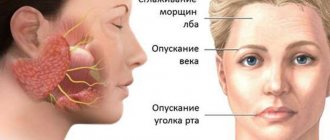Prevention and treatment of optic neuritis
Ophthalmologists call neuritis a degenerative process that develops in the trunk and in various parts of the nerve membranes of the eye and has an inflammatory etiology. The pathology is detected in an acute form against the background of a decrease in immune function with simultaneous general or local damage to neurons by pathogens of a bacterial or infectious nature. Among the symptoms common to various types of damage, experts name a decrease in visual acuity, a violation of the contrast of color perception, the appearance of characteristic elements in the form of scotomas, and pain. Treatment of optic neuritis is based on the use of anti-inflammatory, decongestant, antiviral, antibacterial, immunostimulating and desensitizing drugs.
Structure
The optic nerve is a structure of the visual system, which is formed by the nerve fibers of the ganglion cells of the retina of the eye. Nerve fibers from the central part of the retina form the central bundles of the optic nerve, and from the peripheral part of the retina - lateral (lateral) bundles. This is taken into account when diagnosing and determining the quality of damage to the optic nerve.
It is supplied predominantly by the branches of the ophthalmic artery. The optic nerve consists of more than a million nerve fibers and ranges from 35 to 55 mm in length, depending on the structure of the skull. In addition to nerve fibers, neuroglia take part in the histological structure of the optic nerve, which performs supporting and nutritional functions.
The left and right optic nerves form a chiasm. Here, 75% of the nerve fibers of the two optic nerves cross. 25% remain unbaptized. In this case, fibers located closer to the center of the optic nerve intersect, but those located along the periphery do not.
Causes of optic neuritis
When listing the causes of optic neuritis, experts emphasize that the pathology in most cases occurs due to the presence of infection in the body. When listing what causes optic neuritis, experts name among the main causes:
- The presence of inflammatory lesions in the brain area, such as meningitis, arachnoiditis or encephalitis.
- Multiple sclerosis.
- Pathologies affecting the sinus area, such as tonsillitis, sinusitis, pharyngitis, tonsillitis or sinusitis.
- Dental diseases such as periodontitis or caries.
- Infection or mechanical damage to bone tissue located in the orbital area, such as phlegmon, periostitis and osteomyelitis.
- The development of infectious lesions of the body of a specific type, for example, diphtheria, typhus, ARVI, tuberculosis, neurosyphilis, gonorrhea.
- Autoimmune pathologies.
In addition to the listed causes of optic neuritis, in a significant number of cases the appearance of pathology is caused by inflammatory processes occurring in the eye area, for example, pathologies such as uveitis, iridocyclitis, choriodiditis.
Pathologies
Depending on the nature of the lesion and pathological symptoms, ophthalmologists divide all diseases of the optic nerve into groups:
- Inflammatory (neuritis);
- Vascular (ischemic damage to the optic nerve);
- Specific nature (syphilitic, tuberculous lesions);
- Tumor;
- Diseases associated with mechanical damage to the optic nerve;
- Pathologies associated with impaired circulation of cerebrospinal fluid in the intershell spaces of the optic nerve;
- Toxic;
- Developmental anomalies.
To diagnose these diseases, ophthalmologists evaluate the patient’s complaints during a survey, pay attention to the dynamics of clinical manifestations, the intensity and rate of progression of pathological symptoms.
Often, an examination of the fundus is performed using pharmacological drugs that temporarily cause mydriasis (dilation of the pupil).
During the study, the condition of the MN is carefully studied.
Determining the acuity of central and peripheral vision during a comprehensive diagnosis often allows ophthalmologists to identify the nature of the damaging processes. For example, during inflammatory or degenerative reactions that affect only the outer layers of the optic nerve, visual acuity in the periphery first deteriorates, and the boundaries of peripheral vision narrow.
Instrumental methods for examining the pathology of the optic nerve and chiasm include clinical, radiological and electrophysiological techniques.
- Clinical: ophthalmochromoscopy, diagnostics of photosensitivity, color perception, ultrasound examination of the eyeball and orbit, Dopplerography of the vessels feeding the optic nerve.
- X-ray: Survey radiography of the skull and eye sockets in various planes, computed tomography.
- Electrophysiological: study of electrical sensitivity and lability of the optic nerve, recording of evoked potentials.
To carry out diagnostics, our clinic offers its patients a whole range of modern devices and techniques that guarantee the best results in the shortest possible time.
Symptoms of optic neuritis
The diagnosis of optic neuritis is often made in patients who have rapid progression of the disease localized in the area of one eye. The severity of symptoms of optic neuritis depends on the form of pathology and the volume of tissue affected by the course of pathological changes. Depending on these factors, the patient may experience a wide range of symptoms, from deterioration of vision to the appearance of intraocular pain caused by increased pressure exerted by swelling to sudden loss of vision. Ophthalmologists distinguish characteristic signs of the disease for retrobulbal and intrabulbal varieties:
Among the features of the intrabulbal variety of the disease, experts include the dynamic development of symptoms that appear a few days after the lesion and last on average for 20-40 days. With this type, the patient may experience the appearance of spots localized in the central part of the image, loss of the ability to distinguish certain shades and visual acuity, up to the onset of blindness in the affected eye.
In contrast, signs of optic neuritis in the retrobulbal form are diagnosed less frequently and manifest themselves mainly in the form of a noticeable decrease in visual acuity or loss of vision. This type of disease has a longer course, the average duration of which is from 5 to 6 weeks. During this time, the patient may experience an increase in body temperature, a feeling of general weakness, migraines, a narrowing of vision in the peripheral vision area and the appearance of pain, the area of which is localized in the brow ridges.
Description
Diseases of the optic nerve are divided into three main groups:
• inflammatory (neuritis); • vascular (optic nerve ischemia); • degenerative (atrophy);
There are descending (retrobulbar) neuritis, when the inflammatory process is localized on any part of the optic nerve from the chiasm to the eyeball, and ascending neuritis (papillitis), in which the intraocular and then the intraorbital part of the optic nerve is involved in the inflammatory process.
When the optic nerve is damaged, functional disorders always occur in the form of decreased central vision, narrowing of the visual field, and the formation of absolute or relative scotomas. Changes in the visual field to white and other colors are one of the early symptoms of optic nerve damage.
With severe damage to the fibers of the optic nerve, amaurotic immobility of the pupil is noted. The pupil of the blind eye is slightly wider than the pupil of the other seeing eye.
In this case, there is no direct and the indirect (friendly) reaction of the pupil to light remains. On the seeing eye, a direct, but no friendly reaction of the pupil to light is preserved. The reaction of the pupils to convergence is preserved.
According to the nature of the lesion and clinical manifestations, diseases of the optic nerve are divided into inflammatory (neuritis), vascular (optic nerve ischemia), specific (tuberculosis, syphilitic), toxic (dystrophic), tumor, associated with damage to the optic nerve, abnormalities of the optic nerve, lesions, associated with impaired circulation of cerebrospinal fluid in the optic nerve sheath (congestive disc), optic nerve atrophy.
To study the morphological and functional state of the optic nerves, clinical, electrophysiological and radiological research methods are used. Clinical methods include the study of visual acuity and field (perimetry, campimetry), contrast sensitivity, critical flicker fusion frequency, color perception, ophthalmoscopy (direct and reverse), ophthalmochromoscopy, as well as fluorescein angiography of the fundus, ultrasound examination of the eye and orbit, Dopplerography vessels of the internal carotid artery (ophthalmic and supratrochlear arteries).
Electrophysiological methods include the study of electrical sensitivity and lability of the optic nerve (ESiL) and recording of visual evoked potentials (VEP).
Radiological methods for studying the optic nerve include survey radiography of the skull and orbit (front and profile images), examination of the bony canal of the optic nerve, computed tomography and magnetic resonance imaging.
In case of optic nerve disease, comprehensive studies are required with consultation of a therapist, neurologist, otolaryngologist and other specialists.
INFLAMMATORY DISEASES OF THE OPTIC NERVE
There are more than two hundred different reasons that cause the clinical manifestations of optic neuritis. In the clinic, a rather conventional division of neuritis into two groups is accepted: intraocular intrabulbar (papillitis) and retrobulbar. Papillitis is characterized by a sharp disruption of the function of the papillary system of the blood-ophthalmic barrier. With an intrabulbar process (papillitis), the dynamics of the clinical picture are well determined ophthalmoscopically. With retrobulbar neuritis, the main thing in diagnosis is the symptoms of visual disturbances and their careful identification, and the ophthalmoscopic picture of the fundus can remain normal for quite a long time.
The main form of retrobulbar neuritis is axial (axial) neuritis, which affects the papillo-macular bundle. The leading symptom of axial neuritis is central scotoma, which manifests itself as a relative or absolute scotoma in white or only in red and green.
The optic disc is a small part of a closed system, which is the eyeball, in particular the eye cavity. The optic disc is the only part where it is possible to visually observe the condition of the anterior end of the optic nerve. Therefore, it is customary to divide inflammation of the optic nerve into:
- intrabulbar (papillitis);
- retrobulbar;
Retrobulbar inflammatory diseases of the optic nerve include ophthalmoscopically invisible processes in the initial stage of development.
Based on topographic location, they are distinguished:
- orbital;
- intracanalicular;
- intracranial lesions;
With papillitis, as a rule, a decrease in visual function is combined with ophthalmoscopically visible changes in the optic nerve head. With retrobulbar lesions of the optic nerve, it most often remains normal at the onset of the disease, but visual acuity and visual field suffer. And only subsequently, after a certain period of time, depending on the location of the damage to the optic nerve and the intensity of the damage, pathological manifestations appear on the disc. These manifestations are defined as characteristic signs visible ophthalmoscopically - inflammatory changes in the disc or only in the form of descending atrophy of its fibers.
The main signs of optic neuritis consist of the appearance of inflammatory exudate, edema, compression of nerve fibers by edema and the toxic effect of exudate on them. This is accompanied by small cell lymphoid infiltration and proliferation of neuroglia. In this case, the myelin sheaths and axial cylinders of the optic fibers undergo dystrophy, degeneration and subsequent atrophy. Human optic nerve fibers do not have any regenerative ability. After degeneration of the nerve fiber (axon), its mother retinal ganglion cell dies. When a diagnosis of optic neuritis is made, it is necessary to urgently use medications aimed at suppressing the inflammatory process in the area of damage to the optic nerve, reducing tissue edema and capillary permeability, limiting exudation, proliferation and destruction.
Treatment of patients with optic neuritis should be emergency in a hospital setting and directed against the underlying disease that caused the neuritis. In recent years, two stages have emerged in the tactics of treating neuritis: the first stage is immediate provision of assistance until the etiology of the process is clarified; the second stage is carrying out etiological treatment after identifying the cause of the disease.
Intrabulbar ascending neuritis (papillitis) of the optic nerve
The cause is brucellosis, syphilis, etc.), focal infections (tonsillitis, sinusitis, otitis, etc.), inflammatory processes in the inner membranes of the eye and orbit, general infectious diseases (blood diseases, gout, nephritis, etc.). With ascending neuritis, the intrabulbar part of the optic nerve (disc) is initially affected. Subsequently, as the inflammatory process spreads, the retrobulbar part of the optic nerve is affected.
The clinical picture depends on the severity of the inflammatory process. With mild inflammation, the optic disc is moderately hyperemic, its boundaries are unclear, the arteries and veins are somewhat dilated. A more pronounced inflammatory process is accompanied by a sharp hyperemia of the disc, its borders merge with the surrounding retina. Exudative foci appear in the peripapillary zone of the retina and multiple small hemorrhages, arteries and veins dilate moderately. Usually the disc does not proliferate with neuritis. The exception is cases of neuritis with edema.
The main distinguishing feature of optic nerve papillitis from a congestive disc is the lack of protrusion of the disc above the level of the surrounding retina. The appearance of even single small hemorrhages or exudative lesions in the tissue of the disc or surrounding retina is a sign of optic nerve papillitis.
Papillitis is characterized by early impairment of visual functions - decreased visual acuity and changes in the visual field.
Decreased visual acuity depends on the degree of inflammatory changes in the papillomacular bundle. Usually there is a narrowing of the boundaries of the visual field, which may be concentric or more significant in one of the areas. Central and paracentral scotomas appear. Narrowing of the peripheral boundaries of the visual field is often combined with scotomas. A sharp narrowing of the field of vision to red and impaired color perception are also characteristic. There is a decrease in electrical sensitivity and lability of the optic nerve. Dark adaptation is disrupted. When neuritis passes into the atrophy stage, the disc turns pale, the arteries narrow, exudate and hemorrhages resolve.
Treatment should be timely (early) in a hospital setting. Once the cause is identified, the underlying disease is treated. In cases of unclear etiology, broad-spectrum antibiotic therapy is indicated. Use ampiox 0.5 g 4 times a day for 5-7 days, ampicillin sodium salt 0.5 g 4 times a day for 5-7 days, cephaloridine (zeporin) 0.5 g 4 times a day for 5-7 days, gentamicin, netromycin. Fluoroquinolone drugs are also used - maxaquin, tarivid. Be sure to use vitamins: thiamine (B) and nicotinic acid (PP). A 2.5% solution of thiamine is administered intramuscularly, 1 ml daily, for a course of 20-30 injections, a 1% solution of nicotinic acid, 1 ml daily for 10-15 days. Vitamin B2 (riboflavin) is given orally, 0.005 g 2 times a day, ascorbic acid (vitamin C) 0.05 g 3 times a day (after meals). Dehydration therapy is indicated: 25% magnesium sulfate solution 10 ml is administered intramuscularly, 10% calcium chloride solution 10 ml is administered intravenously, diacarb 0.25 g is administered orally 2-3 times a day, after 3 days of administration, a break of 2 days is taken; indomethacin 0.025 g. Corticosteroids are used to reduce inflammation. Dexamethasone is given orally at 0.5 mg (0.0005 g), 4-6 tablets per day. After improvement of the condition, the dose is gradually reduced, leaving a maintenance dose of 0.5-1 mg (0.0005-0.001 g) per day for 2 doses after meals. A 0.4% solution of dexamethasone (dexazone) is administered retrobulbarically, 1 ml per day, for a course of 10-15 injections.
Retrobulbar descending optic neuritis
Significant difficulties arise in determining the etiology of retrobulbar neuritis. About half of them end up with an unknown cause. Retrobulbar neuritis often occurs with multiple sclerosis, neuromyelitis optica, and diseases of the paranasal sinuses. The most common causes of neuritis are basal leptomeningitis, multiple sclerosis, diseases of the paranasal sinuses, viral (influenza) infection, etc. Sometimes retrobulbar neuritis is the earliest sign of multiple sclerosis. The group of retrobulbar neuritis includes all descending neuritis (regardless of the condition of the optic nerve head). Compared to inflammation of the optic nerve head (papillitis), inflammation of the optic nerve trunk is observed much more often and manifests itself in the form of interstitial neuritis.
With retrobulbar neuritis, inflammation is localized in the optic nerve from the eyeball to the chiasm.
Cases of primary inflammation of the optic nerve in its orbital part are relatively rare.
Retrobulbar neuritis most often develops in one eye. The second eye gets sick some time after the first. Simultaneous disease of both eyes is rare. There are acute and chronic retrobulbar neuritis. Acute neuritis is characterized by pain behind the eyeballs, photophobia and a sharp decrease in visual acuity.
In a chronic course, the process increases slowly, visual acuity decreases gradually. Based on the state of visual functions (visual acuity and visual field), all descending neurites are divided into axial neurites (lesions of the papillomacular bundle), perineuritis and total neuritis.
With ophthalmoscopy at the onset of retrobulbar neuritis, the fundus may be normal. The optic disc is normal or more often hyperemic, its boundaries are unclear. Retrobulbar neuritis is characterized by a decrease in visual acuity and the detection of a central absolute scotoma in the field of view of white and colored objects. At the beginning of the disease, the scotoma is large in size; later, if visual acuity increases, the scotoma decreases, becomes relative, and disappears if the course of the disease is favorable. In some cases, the central scotoma turns into a paracentral annular scotoma. The contrast sensitivity of the organ of vision decreases. The disease can lead to descending atrophy of the optic nerve head. The blanching of the optic disc can vary in extent and intensity; blanching of its temporal half is more common (due to damage to the papillomacular bundle). Less commonly, with a diffuse atrophic process, uniform blanching of the entire disc is observed.
Treatment of retrobulbar neuritis depends on the etiology of the inflammatory process and is carried out according to the same principles as the treatment of patients with papillitis. The prognosis for retrobulbar neuritis is always serious and depends mainly on the etiology of the process and the form of the disease. With an acute process and timely rational treatment, the prognosis is often favorable. In chronic cases, the prognosis is worse.
VASCULAR DISEASES OF THE OPTIC NERVE
Acute obstruction of the arteries supplying the optic nerve
Vascular pathology of the optic nerve is one of the most difficult problems in ophthalmology due to the extreme complexity of the structural and functional structure and arteriovenous circulation in various parts of the optic nerve. There are two main forms of vascular lesions of the optic nerve: arterial and venous. Each of these forms can occur as an acute or chronic disease. Vascular diseases of the optic nerve belong to polyetiological disease processes.
The etiology of ischemia is thrombosis, embolism, stenosis and obliteration of blood vessels, prolonged spasms, disturbances in the rheological properties of blood, diabetes mellitus. These are mainly elderly patients with general vascular diseases, severe atherosclerosis and hypertension.
Pathogenesis: Pathogenesis is based on disturbances (reduction) of blood flow in the vessels supplying the optic nerve. Ischemic optic neuropathy is a deficiency of blood supply to nerve tissue, a decrease in the number of functioning capillaries, their closure, disruption of tissue metabolism, an increase in hypoxia and the appearance of under-oxidized metabolic products (lactic acid, pyruvate, etc.).
A. ANTERIOR ISCHEMIC NEUROPATHY OF THE OPTIC NERVE
In the pathogenesis of anterior ischemic optic neuropathy, the main factors are stenosis or occlusion of the arterial vessels supplying the optic nerve, and the resulting imbalance between the perfusion pressure in these vessels and the level of intraocular pressure. The main role is played by circulatory disorders in the system of the posterior short ciliary arteries. There is a rapid (within 1-2 days) decrease in vision down to light perception. Central scotomas appear in the field of view, more often the lower half of the field of vision falls out, less often sector-shaped loss are observed in the field of view. These changes occur more often in elderly patients due to spasm or are organic in nature (atherosclerosis, hypertension, endarteritis, etc.).
At the very beginning of the disease, the fundus of the eye may be unchanged, then on the 2nd day, ischemic edema of the optic disc and cotton wool-like edema of the retina around it appear. The arteries are narrowed, in places in the edematous retina (in the area of the disk or around it) they are not identified. The macula area is unchanged. Subsequently, the swelling of the optic disc decreases, and the disc becomes paler. By the end of the 2-3rd week of the disease, atrophy of the optic nerve of varying severity occurs. Due to the rapid deterioration of visual acuity, early treatment is necessary.
The diagnosis of anterior ischemic neuropathy is facilitated by Doppler ultrasound detection (in approximately 40% of cases) of stenotic lesions of the carotid arteries; using laser Doppler ultrasound, it is possible to determine capillary circulation disorders in the optic nerve head.
Treatment: Urgent hospitalization. Immediately after diagnosis, vasodilators, thrombolytic drugs and anticoagulants are prescribed. Give a nitroglycerin tablet (0.0005 g). Intravenous injection of 5-10 ml of 2.4% solution of aminophylline along with 10-20 ml of 40% glucose solution daily, 2-4 ml of 2% solution of no-shpa (slowly!), 15% solution of xanthinol nicotinate (complamin) - 2 ml 1-2 times a day (injected very slowly, the patient is in a lying position). Retrobulbar administration of 0.3-0.5 ml of 0.4% dexazone solution, 700-1000 units of heparin, 0.3-0.5 ml of 1% emoxypine solution is indicated.
During the development of papilledema, patients must be prescribed thiazide 0.05 g once a day before meals for 5-7 days followed by a break of 3-4 days, furosemide 0.04 g once a day, brinaldix 0 .02 g once a day, 50% glycerol solution at the rate of 1-1.5 g/kg, ethacrynic acid 0.05 g. Treatment is continued for 1.5-2 months. Patients should be consulted by a therapist and a neurologist
B. POSTERIOR ISCHEMIC NEUROPATHY OF THE OPTIC NERVE
Posterior ischemic optic neuropathy occurs mainly in older people and occurs against the background of general (systemic) diseases, such as hypertension, atherosclerosis, diabetes mellitus, collagenosis, etc. As with anterior ischemic neuropathy, the main factor in the development of this disease is the narrowing , stenosis, spasm or occlusion of the arterial vessels supplying the posterior parts of the optic nerve. Doppler ultrasound in such patients often reveals stenosis of the internal and common carotid arteries.
The disease begins acutely. Patients complain of a sharp decrease in visual acuity. Various defects are detected in the field of view: sectoral loss mainly in the inferior nasal region, concentric narrowing of the fields. Ophthalmoscopic examination during this period does not reveal any changes in the optic nerve head.
The diagnosis of the disease is helped by electrophysiological studies that reveal a decrease in electrical sensitivity and lability of the optic nerve and an increase in the travel time of the nerve impulse along the visual pathway.
Doppler studies of the carotid, ophthalmic and supratrochlear arteries often reveal changes in blood flow parameters in these vessels. After 4-6 weeks, blanching of the optic disc begins to appear in the sector that corresponds to the missing area in the field of view. Then simple descending atrophy of the optic nerve gradually develops. Excavation of the optic nerve head is not detected in this pathology.
This pathology presents great difficulties for early diagnosis. It is much less common than anterior ischemic neuropathy. In this case, the venous circulation in the optic nerve is disrupted to one degree or another. This process is in the vast majority of cases one-sided.
Treatment is similar to that for anterior ischemic neuropathy. Despite the treatment, visual acuity often remains low, and persistent defects are determined in the field of vision of patients - absolute scotomas.
How to treat optic neuritis
Depending on the area of localization of the disorder, ophthalmologists distinguish several types of the disease that arise as a result of local damage to the organ, leading to inflammatory processes, the development of which causes necrotization of damaged tissues. In order to determine a strategy for how to cure optic neuritis, the disease is diagnosed, based on the results of which the ophthalmologist hospitalizes the patient and prescribes a comprehensive treatment plan. Before treating optic neuritis, diagnostic procedures determine the etiology of the disease, depending on which the doctor can prescribe therapy using:
- anti-inflammatory medications;
- drugs that correct the functioning of the immune system;
- medicines from the group of antibiotics, with the exception of medicines from the group of aminoglycosides;
- corticosteroids;
- antiviral agents;
- drugs that regulate metabolism;
- antibacterial drugs;
- vitamin therapy using biologically active substances of group B;
- desensitizing drugs;
- medications intended to improve blood microcirculation;
- antispasmodics.
When it is established that the body is damaged by one of the types of infection, localized in the nasopharynx, respiratory organs or other structures, in addition to the course of treatment for optic neuritis prescribed by the doctor, the causes that caused the appearance of the background disease are eliminated.
Relevance
Many visual impairments develop as a result of damage to the nerve pathways, rather than organic damage to the structures of the eye.
Normal vision is ensured through the clear functioning of 3 components of the visual system:
- Anatomical structures of the visual analyzer (eye);
- Conducting nerve pathways (through which impulses from the retina reach the visual centers of the cerebral cortex);
- Areas of the cerebral cortex (visual centers of the cerebral hemispheres, mainly the calcarine sulcus).
Congenital or acquired pathologies of the conductive nerve fibers are a common cause of visual impairment, including complete blindness. Doctors divide pathologies of this nature depending on their occurrence:
- Primary (occurred for the first time);
- Secondary (developed against the background of other diseases of the visual system or pathologies of a systemic nature).
Lesions of the visual system pathways do not always appear in the initial periods of disease development.
But the speed of their progression, restoration of the quality of vision and improvement of a person’s quality of life depend on timely and rationally selected treatment tactics.
Stages and degrees of optic neuritis
Ophthalmologists distinguish several types of pathology, differing from each other in the reason that caused the appearance of the disorder. In addition, experts distinguish such stages of optic neuritis as:
- Intrabulbal neuritis, a distinctive feature of which is a change in the shape of the optic nerve head and the spread of the inflammatory process not extending beyond the apple, is distinguished by the fact that it is most common in young patients.
- The combination of the previous type of lesion with degenerative changes occurring in the area of the nerve endings of the retina is observed quite rarely and is usually a consequence of an infectious or viral lesion.
- Retrobulbal neuritis is observed in a significant percentage of cases associated with multiple sclerosis. This type of pathology is characterized by the fact that in the initial stages it does not allow recording visual changes in the optic nerve disc, which is observed as the disease progresses at the stage of the nerve leaving the orbit.
Ophthalmologists emphasize the conventionality of distinguishing the degrees of optic neuritis, since due to various combinations of necrotization processes and inflammatory tendencies, the difference between the listed types of pathology can be conditional.
Pathogenesis
Inflammation of the optic nerve can involve both the trunk and the optic nerve sheath. The small cell infiltration/inflammatory edema that develops, including in the optic nerve head, causes compression of the optic fibers with gradually developing degeneration, which causes a sharp decrease in visual acuity. Some fibers, after the acute inflammatory process subsides, can restore their function, which is manifested clinically by an improvement in vision. In severe cases of optic neuritis, disintegration of nerve fibers and their replacement by glial tissue may occur with the development of optic nerve atrophy, accompanied by irreversible impairment of the function of the visual analyzer (decrease in visual acuity).
In addition to the inflammatory process in the optic nerve, its damage may be based on the process of destruction of its myelin sheath (demyelination of nerve fibers), which occurs in multiple sclerosis . Demyelinating lesions of the optic nerve are in practice referred to as retrobulbar neuritis .
The above pathological processes cause dysfunction of the visual analyzer (transmission of information from the retinal receptors that perceive the image), which is clinically manifested by a decrease in visual acuity/disorder of color perception or loss in the optical fields. As the disease progresses, irreversible damage occurs to an increasing number of optical fibers with the gradual filling of the areas of destruction with growths of connective tissue.
Diagnostic methods
In order to get rid of eye pain, you need to undergo an examination. The Clinical Institute of the Brain has all the conditions for a full diagnosis of diseases of the visual apparatus. An ophthalmologist will examine the fundus of the eye and collect material for testing for infectious microflora.
There are several main methods for diagnosing eye pain:
- ophthalmoscopy - examination of the fundus and assessment of the transparency of eye structures using an ophthalmoscope;
- measurement of intraocular pressure - can be carried out by assessing the imprints of small weights on the retina or using tonometers;
- biomicroscopy - examination of the internal and external structures and membranes of the eye using light refraction at different angles;
- confocal microscopy of the cornea - hardware examination of this membrane;
- Vesta color test - used to study the patency of the lacrimal ducts;
- various methods for studying visual fields;
- Ultrasound of the eyeball;
- studying eyelid scrapings under a microscope to exclude demodicosis and others.
If a headache puts pressure on the eyes, the condition of the brain and its membranes is further examined. Diagnosis is carried out using MRI or CT - the most accurate methods of obtaining a three-dimensional image of internal structures. You may also need x-rays of your sinuses, blood tests, and other tests.
Treatment of eye pain
Treatment of eye diseases should be carried out under the supervision of a specialist. Our clinic employs doctors of narrow and broad profiles, whose qualifications allow us to quickly make the correct diagnosis and prescribe effective treatment. The course of therapy is selected individually and depends on the diagnostic results. It may include the following steps:
- taking medications (antibiotic therapy, anti-inflammatory drugs, vitamins, symptomatic medications - analogues of tears and other medications according to indications);
- gymnastics to strengthen the muscles of the eyeball;
- surgical treatment, including modern methods of vision correction.
Pain in the eyes often develops when the visual organ is overworked. This is due to monotonous work at the monitor, lack of vitamins and microelements in the diet, and incorrect selection of vision correction products (glasses or lenses). To prevent diseases of the visual system, it is recommended to perform simple gymnastics and undergo regular examinations. Doctors at the Clinical Brain Institute will be able to identify dangerous pathologies in the early stages and help maintain visual acuity at any age.
Clinical Brain Institute Rating: 4/5 — 19 votes
Share article on social networks
Prognosis and prevention
With the development of ischemic optic neuropathy, the prognosis is unfavorable. Even with timely treatment, a significant decrease in vision often persists, and peripheral vision defects remain, which is caused by optic nerve atrophy. Only in 50% of patients is it possible to improve vision by 0.1 or 0.2. Damage to both eyes often results in further low vision or complete blindness.
Prevention of ischemic optic neuropathy should include timely treatment of vascular and systemic pathologies. For those who have suffered ischemic neuropathy of one eye, follow-up with an ophthalmologist and regular preventive therapy are indicated.
By contacting the Moscow Eye Clinic, each patient can be sure that some of the best Russian specialists will be responsible for the results of treatment. The high reputation of the clinic and thousands of grateful patients will certainly add to your confidence in the right choice. The most modern equipment for the diagnosis and treatment of eye diseases and an individual approach to the problems of each patient are a guarantee of high treatment results at the Moscow Eye Clinic. We provide diagnostics and treatment for children over 4 years of age and adults.
You can find out the cost of a particular procedure or make an appointment at the Moscow Eye Clinic by calling in Moscow 8 (499) 322-36-36 (daily from 9:00 to 21:00) or using the ONLINE REGISTRATION FORM.










